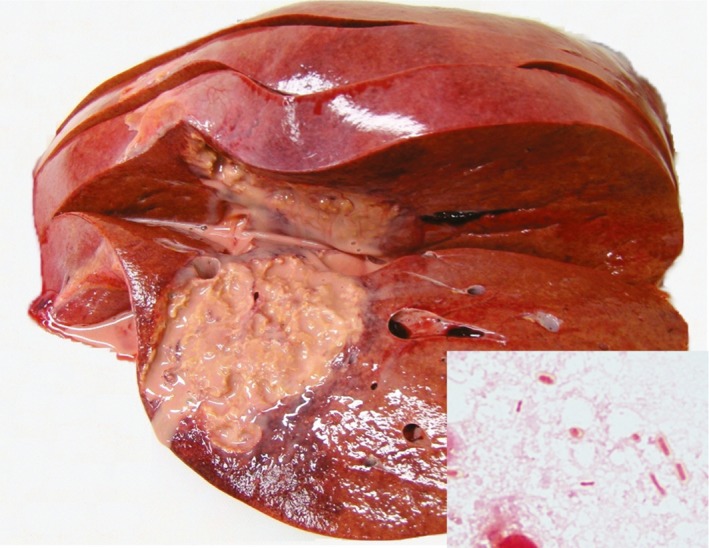Abstract
Klebsiella pneumoniae liver abscess is no longer fatal but causes catastrophic disabilities. To prevent severe complications, early diagnosis is essential. Gram stain and string test are important for early diagnosis.

Keywords: Gram stain, hypermucoviscosity phenotype, Klebsiella pneumoniae liver abscess, Klebsiella pneumoniae, string test
A 63‐year‐old Japanese man with diabetes mellitus was admitted because of high fever. Before a detailed clinical evaluation could be performed, he suffered a bout of shivering and suddenly died. An autopsy revealed liver abscesses, for which pus smears showed many large Gram‐negative bacilli with capsule formation (Figure 1). Septic emboli were apparent in many organs. In the lungs, purulent pneumonia and alveolar hemorrhage were also evident. Cultures of blood and liver abscesses demonstrated growth of Klebsiella pneumoniae (K. pneumoniae). Spreading of K. pneumoniae colonies on agar plates resulted in formation of strings >5 mm in length, demonstrating a hypermucoviscosity phenotype (Figure 2). The patient was finally diagnosed as dying of septic shock due to “Klebsiella pneumoniae liver abscess” (KPLA).1, 2
Figure 1.

Autopsy findings of the liver: Liver abscess, measuring 7 cm in long diameter, is full of pus and debris. Inset, Gram stain examination of the pus reveals many large Gram‐negative bacilli with capsule formation (original magnification ×1000 with oil immersion)
Figure 2.

String test: Spreading K. pneumoniae colonies on the agar plate forms a string >5 mm in length, demonstrating a hypermucoviscosity phenotype
KPLA is clinically characterized by liver abscesses and consequent bloodstream pyogenic infections such as endophthalmitis and meningitis. KPLA is generally no longer fatal but causes catastrophic disabilities due to irreversible ocular and central nervous system complications.1, 2, 3 Prevalence of KPLA has been observed worldwide with predominance in Southeast Asia.1 Diabetes mellitus and an Asian ancestry are known to be predisposition factors.1, 2 KPLA is caused by hypervirulent strains of K. pneumoniae, which feature a hypermucoviscosity phenotype and expression of capsular K1 or K2 antigens as well as magA (mucoviscosity‐associated gene A) and/or rmpA (regulator of mucoid phenotype A) genes. The hypermucoviscosity phenotype is defined by the string test, which monitors the formation of viscous strings of greater than 5 mm in length on spreading with an inoculation loop. The hypervirulent strains of K. pneumoniae (also known as serotype K1‐K. pneumoniae) have been reported not only in Asian countries but also in other areas of the world.1, 3
For KPLA, early diagnosis and aggressive therapy are essential to prevent serious complications. Therefore, awareness of clinical symptoms is important. Gram stain examination of purulent discharges from liver abscesses can lead to immediate pathognomonic diagnosis. Therefore, generalist physicians, as potential first‐line physicians or consultants, should be familiar with the characteristic morphology of K. pneumoniae, that is, “large Gram‐negative bacilli with capsule formation”. Furthermore, for rapid detection of hypervirulent strains, the string test should be well recognized and aggressively employed as a useful method that can be easily performed in community hospital laboratories.4
CONFLICT OF INTEREST
The author has stated explicitly that there are no conflicts of interest in connection with this article.
ACKNOWLEDGEMENTS
None.
Chinen K. Klebsiella pneumoniae liver abscess. J Gen Fam Med. 2017;18:466–467. https://doi.org/10.1002/jgf2.90
REFERENCES
- 1. Siu LK, Yeh K‐M, Lin J‐C, Fung C‐P, Chang F‐Y. Klebsiella pneumoniae liver abscess: a new invasive syndrome. Lancet Infect Dis. 2012;12:881–7. [DOI] [PubMed] [Google Scholar]
- 2. Lee SS‐L, Chen Y‐S, Tsai H‐C, et al. Predictors of septic metastatic infection and mortality among patients with Klebsiella pneumoniae liver abscess. Clin Infect Dis. 2008;47:642–50. [DOI] [PubMed] [Google Scholar]
- 3. Maruno T, Ooiwa Y, Takahashi K, et al. A liver abscess deprived a healthy adult of eyesight: endogenous endophthalmitis associated with a pyogenic liver abscess caused by serotype K1 Klebsiella pneumonia . Inter Med. 2013;52:919–22. [DOI] [PubMed] [Google Scholar]
- 4. Hadano Y. String test. BMJ Case Rep. 2013;pii:bcr2012008328 https://doi.org/10.1136/bcr-2012-008323. [DOI] [PMC free article] [PubMed] [Google Scholar]


